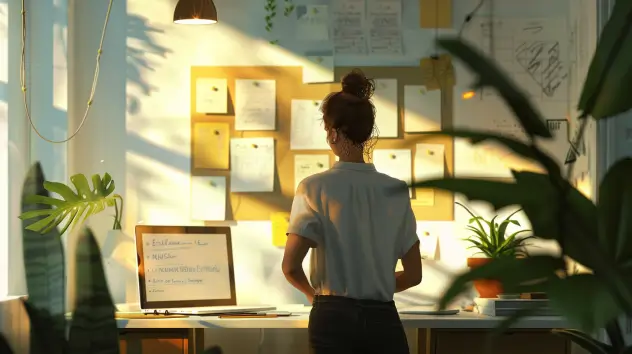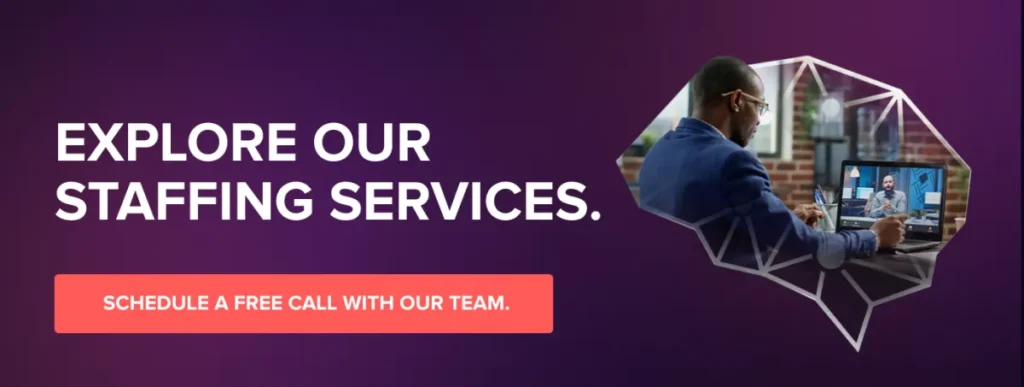Introduction

Imagine standing at the threshold of an expansive gallery, where every piece of artwork, from the subtlest sketch to the most vibrant painting, tells a unique story of imagination meeting execution. This gallery, vast and varied, is a metaphor for the world of graphic design—a realm where creativity meets career, and individual visions find their place in the vocational landscape. Welcome to “Crafting and Responding to the Perfect Graphic Designer Job Description: Insights for Employers and Candidates,” a guide that serves as both map and muse for navigating this dynamic industry.
If your goal is to discover the ultimate job description template that stands as a benchmark for crafting your hiring specifications, especially for a graphic designer position, then you’ve come to the right place. The link below grants you immediate access to our complimentary job description template, meticulously designed to encapsulate the core principles and superior practices of C9Staff’s esteemed hiring methodology. This document is not merely a template; it’s a comprehensive guide that assures you attract the finest talent by providing clarity and precision in your job postings. Empower your recruitment process today with a tool that has been crafted with excellence at its core.
Graphic designer Job description template

The job description, in this context, is much more than a list of qualifications and duties. For employers, it is the blueprint for constructing opportunities that attract not just any talent, but the right talent—the architects of opportunity crafting calls to action that resonate with the essence of the desired creator. For candidates, it represents a canvas, awaiting the brushstrokes of their skills, aspirations, and personal flair—a chance to align their career masterpiece with the galleries eager to display their work.
Our dual objectives unfold as a journey through creation and response. For employers, we delve into the art of sculpting job descriptions that capture the essence of the role and the spirit of the company, highlighting the importance of clarity, vision, and the nuanced dance of attracting the right collaborators. For candidates, we provide the palette and brushes needed to interpret these calls, offering insights on how to tailor their portfolios and resumes into masterpieces that stand out in the crowded gallery of applicants.
As you embark on this voyage of discovery, understanding, and professional growth, consider this article a bridge over the chasm between creation and opportunity. For those navigating the graphic design job market, let it be a beacon that guides you to shores brimming with potential and promise. We invite you to engage deeply with the insights and stories that follow, each designed to enrich, educate, and inspire. Welcome to the journey of crafting and responding to the perfect graphic designer job description—a path that leads to fulfilling the grand tapestry of the graphic design industry with your unique contributions.
The Employer’s Guide to Writing a Graphic Designer Job Description
In the tapestry of any organization, the graphic designer acts as a pivotal thread, weaving together creativity and technical skill to produce designs that tell a story, convey messages, and captivate audiences. This unique blend of abilities makes the role of a graphic designer indispensable, as they turn abstract ideas into tangible visuals that drive engagement and communication. However, capturing the essence of such a dynamic role within a job description requires introspection and strategic alignment. The first step is to deeply understand not just the tasks the designer will perform, but also how this role fits into the broader narrative of your organization’s mission and culture. A well-aligned job description does more than list qualifications; it acts as a beacon for candidates who are not only capable but are also the right cultural fit—those who will thrive and contribute to your company’s unique environment. This alignment ensures that you attract professionals who share your vision and are motivated by the same values that define your organizational culture, setting the stage for mutual growth and success.
Key Components of an Effective Job Description
Crafting a job description for a graphic designer goes beyond the mere listing of job responsibilities and required skills. It starts with a concise title and summary that captures the essence of the role, making it clear and appealing to the right candidates. This title should resonate with the creative nature of the position, enticing those who are looking for opportunities to innovate and express their creativity.
The responsibilities section should offer a balanced view of the role, detailing both the day-to-day tasks and the larger, long-term projects the designer will undertake. It’s important to convey the scope of the position, giving potential candidates a clear understanding of what their workdays might look like and how t hey can contribute to the company’s objectives.
When listing required skills and qualifications, striking a balance between the non-negotiable technical skills and the softer skills that denote a well-rounded candidate is crucial. Highlighting qualities such as creativity, problem-solving, and adaptability, alongside proficiency in design software, paints a picture of the ideal candidate who can not only execute their role effectively but also adapt to and grow with the company.
Introducing your company’s mission, culture, and values in the job description is equally important. This section is your opportunity to sell your company to potential applicants, explaining why someone would want to work for you. It’s about making a compelling case that aligns with what creative professionals v alue in an employer—innovation, a supportive work environment, and the chance to be part of meaningful projects.
Attracting the Right Talent
To attract the right talent, your job posting must stand out. Using compelling language that speaks directly to creative individuals, highlighting the opportunities for growth and development within your company, and clearly defining what makes your company unique are all strategies that can make your job description resonate with the desired audience. Additionally, incorporating relevant keywords ensures that your posting is visible to those actively seeking graphic design positions, making it easier for the right candidates to find you. These keywords should reflect the skills and experiences relevant to the role, as well as the values and culture of your organization.
By creating a job description that is clear, compelling, and aligned with both the needs of the role and the aspirations of potential candidates, employers can set the stage for attracting talent that will not only fulfil l the immediate requirements of the position but will also contribute to the company’s long-term creative and business goals. This approach encourages employers to see the job description not just as a list of demands but as a critical piece of their recruitment strategy, capable of drawing in professionals who will bring value and growth to the team.
If your goal is to discover the ultimate job description template that stands as a benchmark for crafting your hiring specifications, especially for a graphic designer position, then you’ve come to the right place. The link below grants you immediate access to our complimentary job description template, meticulously designed to encapsulate the core principles and superior practices of C9Staff’s esteemed hiring methodology. This document is not merely a template; it’s a comprehensive guide that assures you attract the finest talent by providing clarity and precision in your job postings. Empower your recruitment process today with a tool that has been crafted with excellence at its core.
Graphic Designer Job description template

Unlocking 2024's Vision: A Deep Dive into This Year's Pivotal Graphic Design Trends
Navigating the Landscape of Graphic Designer Job Descriptions - A Candidate's Compass

Deciphering the Job Description
Venturing into the realm of graphic design job listings is akin to exploring a map filled with symbols and paths; each job description offers clues to what lies beyond the written word. The secret to unlocking these cryptic messages? Learning to read between the lines. Employers often encode their company culture, team dynamics, and the true essence of the role within these descriptions. A mention of “fast-paced environment” may hint at the need for exceptional time management skills, while “collaborative projects” suggest a culture of teamwork and open communication.
But beware of red flags and deal-breakers: vague descriptions of responsibilities, unrealistic expectations, or a lack of clarity about the role’s objectives. Such signals can indicate misalignments with your career aspirations or values. Identifying these cues early can save you from embarking on a journey that veers away from your professional path.
Tailoring Your Application
Imagine your resume and portfolio as a curated exhibition of your work, with each piece intentionally chosen to engage with a specific audience—the employer. To resonate with the job description, align your application to mirror the tone, requirements, and desired skills. If the role emphasizes creativity and innovation, highlight projects where you pushed boundaries and explored new concepts. For roles requiring technical proficiency, detail your expertise with the relevant tools and technologies.
The art of customization extends beyond listing skills; it’s about weaving a narrative that showcases your journey, achievements, and the unique perspective you bring to the table. Ensure that your application speaks directly to the employer’s needs, making it impossible for them to overlook your candidacy.
Preparing for the Interview

The interview is your stage, and preparation is key to a standout performance. Anticipate questions derived from the job description—consider how you can demonstrate your proficiency in essential skills, your experience with similar projects, and your ability to integrate into the company culture.
Researching the company’s mission, recent projects, and core values equips you with knowledge to articulate how your vision aligns with theirs. Understanding the company’s culture enables you to present yourself as not only a competent candidate but as someone who can contribute to and thrive within their environment. Prepare stories that highlight your achievements and illustrate your fit both professionally and culturally, ensuring you’re ready to answer with confidence and clarity.
Ready to supercharge your career and land your dream job? C9Staff is here to pave the way. By clicking the link below and submitting your resume to our talent acquisition department, you’re taking the first step towards unlocking exceptional career opportunities. If your qualifications align with our clients’ needs, we’ll reach out to discuss potential roles that match your profile. We specialize in connecting talented individuals with their ideal positions, ensuring a perfect fit based on your skills and aspirations. Don’t miss out on the chance to elevate your career with the support of C9Staff. Submit your resume today and let us help you find where you belong in the professional world.

Unlocking the Secrets of the Portfolio: Essential Insights from Employers
Building Bridges in the Graphic Design Job Market - Communication, Transparency, and the Future
At the heart of every successful employment relationship lies a core of clear communication and transparency. For the graphic design industry, where creativity and innovation are paramount, the clarity in articulating expectations, responsibilities, and company culture becomes even more crucial. Honest and open dialogues between employers and candidates lead to matches that are not just mutually beneficial but also deeply meaningful. These interactions set the stage for a work relationship built on trust and mutual respect, where both parties understand and align with each other’s vision and goals.
Enhancing transparency throughout the hiring process involves a few strategic steps. Employers can start by crafting detailed and clear job descriptions that go beyond just listing skills and qualifications, to sharing insights into the company culture and what a day in the role might look like. Candidates, on their part, should strive to be open about their skills, experiences, and professional aspirations. This mutual openness not only streamlines the recruitment process but also ensures that the fit is right on both ends, laying a solid foundation for future success.
Future Trends in Graphic Design Hiring
Looking towards the future, the graphic design job market is set to evolve dramatically, shaped by new technologies, media, and work patterns. Skills and qualifications are in a constant state of flux, responding to the needs of an industry at the forefront of digital innovation. Designers today need to be not just creative but also technologically savvy, adaptable to new tools and media that emerge.
The rise of remote work and digital collaboration tools has had a profound impact on the hiring landscape. These trends have expanded the talent pool beyond geographical constraints, allowing companies to tap into a global network of talent. For designers, this means opportunities to work with leading firms and on exciting projects without the need to relocate. However, it also means that the competition is no longer just local but global.
Adapting to these changes requires both employers and candidates to be more flexible and innovative in their approach. Companies might need to rethink their recruitment strategies, placing greater emphasis on digital proficiency and the ability to work effectively in remote or hybrid models. Designers, in turn, should focus on continuously upgrading their skills and being proficient in using digital collaboration tools, preparing themselves for the future of work that is already here.
Are you looking to seamlessly integrate the ideal graphic designer into your organization? Discover how C9Staff can streamline the process for you, from sourcing and recruiting to training, managing, and deploying the best-fit talent. Click the link below to schedule a complimentary exploratory call with one of our dedicated account managers. In this conversation, we’re committed to understanding your unique needs and preferences, providing you with personalized candidate endorsements at no cost. This is your opportunity to evaluate the finest talent available, ensuring you secure top-notch professionals at competitive prices. Let us assist you in making your talent acquisition journey smooth and efficient.

Conclusion
As we conclude our exploration of “Crafting and Responding to the Perfect Graphic Designer Job Description: Insights for Employers and Candidates,” we reflect on the journey we’ve taken through the intricate dance of job description crafting and the strategic maneuvers of job application. This guide has illuminated the paths for both employers and candidates, emphasizing the art of creating job descriptions that capture the essence of roles and company cultures, and the science behind navigating these descriptions for mutual success.
For employers, we underscored the necessity of drafting detailed, transparent job descriptions that serve as the foundation for attracting candidates who are not just skilled but also perfectly aligned with the company’s ethos. For candidates, we navigated the nuanced landscape of interpreting these descriptions, identifying opportunities for growth, and presenting oneself as the ideal fit. The threads of communication, transparency, and adaptability to future trends emerged as the pillars supporting the entire process, ensuring that the job market remains dynamic, inclusive, and innovative.
As we part ways, let this guide not be an end but a beginning—to view each job description and application as stepping stones towards greater alignment and growth. Employers and candidates alike are encouraged to embrace these processes as opportunities to discover, connect, and evolve together. The landscape of graphic design employment is ever-changing, ripe with opportunities for those willing to adapt, learn, and engage.
I urge you, the reader, to continue exploring this topic beyond these pages. Engage in discussions, participate in forums, and immerse yourself in community resources. Let the insights gleaned here inspire you to contribute to an industry that thrives on creativity, clarity, and forward-thinking. Together, let’s shape a future that celebrates every individual’s contribution to the tapestry of graphic design, fostering a community where every job description and application becomes a bridge to new possibilities.



